Business Analysis Report: Business Analysis Concepts and Stakeholders
VerifiedAdded on 2022/12/19
|7
|1016
|64
Report
AI Summary
This report provides a comprehensive overview of business analysis, addressing key concepts, roles, and responsibilities of a business analyst. It begins by defining a business analyst and outlining their primary duties, including analyzing business domains, assessing systems, and integrating technology effectively. The report then explores the core competencies required for the role, such as leadership, communication, and organizational skills. It delves into the Business Analysis Core Concept Model (BACCM), explaining its framework for organizational change and stakeholder value. Furthermore, the report identifies and analyzes stakeholders, emphasizing the importance of both internal (employees) and external (customers) stakeholders. It offers practical tips for problem definition and concludes by discussing the vision of a project and its significance. The report is supported by references to relevant academic sources.
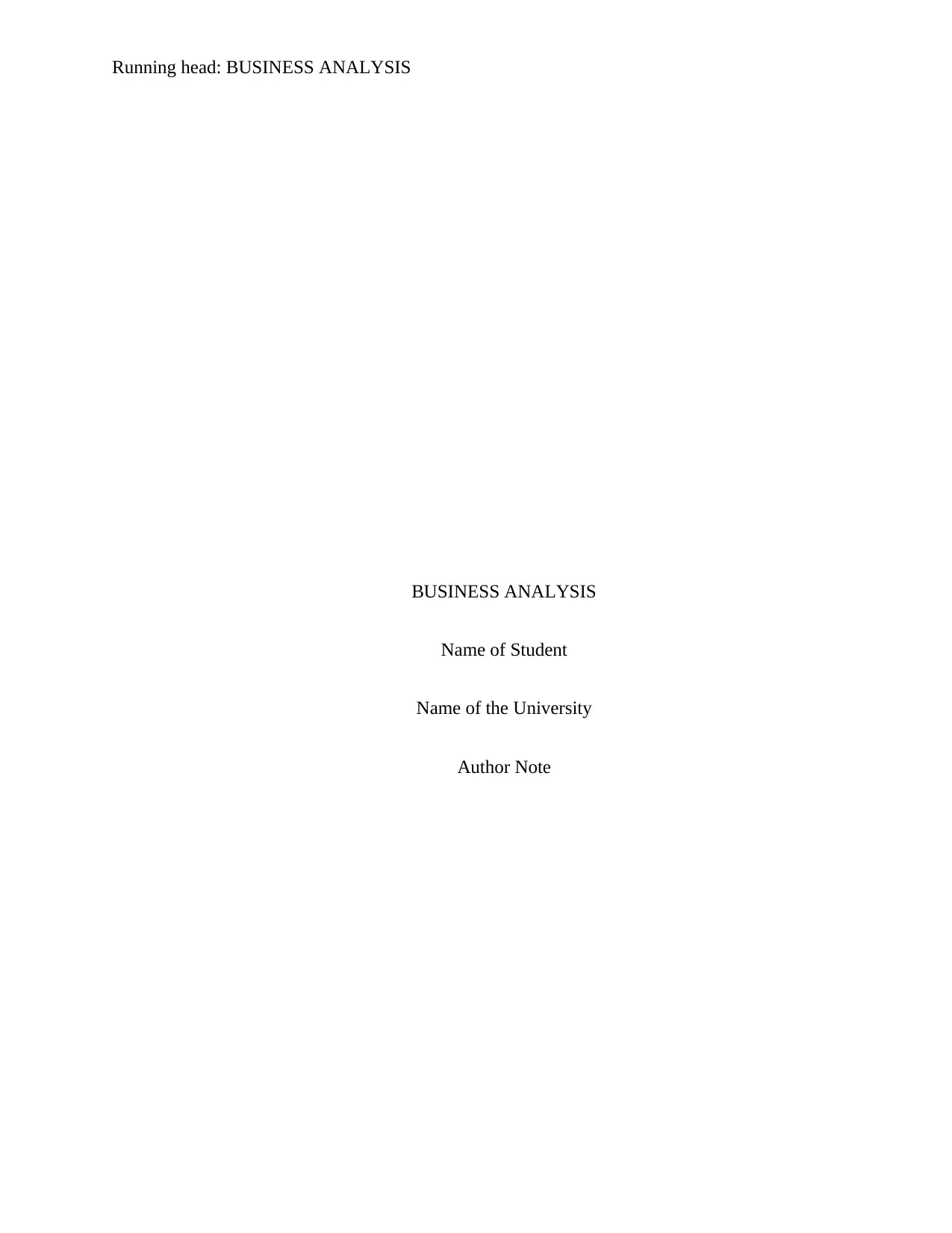
Running head: BUSINESS ANALYSIS
BUSINESS ANALYSIS
Name of Student
Name of the University
Author Note
BUSINESS ANALYSIS
Name of Student
Name of the University
Author Note
Paraphrase This Document
Need a fresh take? Get an instant paraphrase of this document with our AI Paraphraser
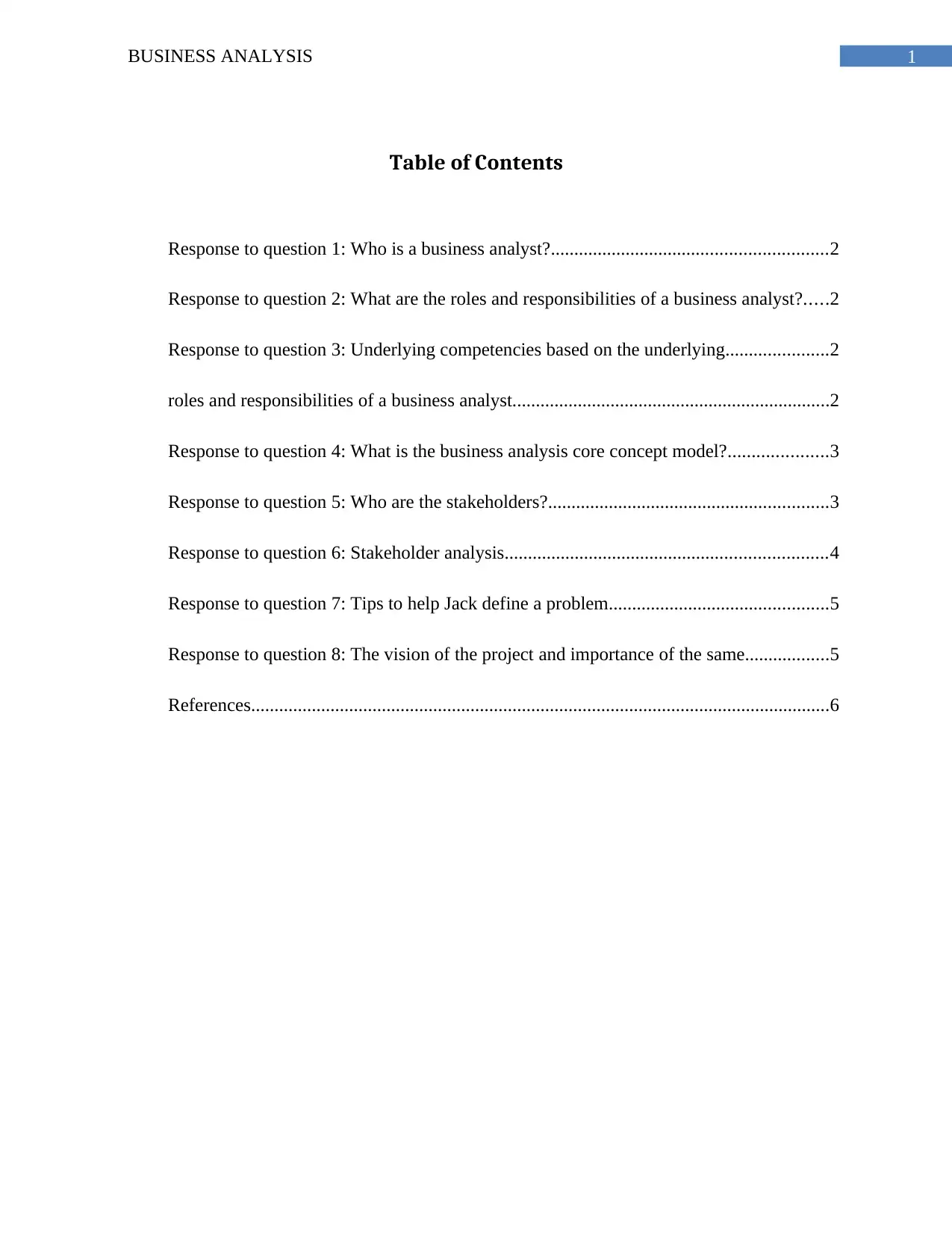
1BUSINESS ANALYSIS
Table of Contents
Response to question 1: Who is a business analyst?...........................................................2
Response to question 2: What are the roles and responsibilities of a business analyst?.....2
Response to question 3: Underlying competencies based on the underlying......................2
roles and responsibilities of a business analyst....................................................................2
Response to question 4: What is the business analysis core concept model?.....................3
Response to question 5: Who are the stakeholders?............................................................3
Response to question 6: Stakeholder analysis.....................................................................4
Response to question 7: Tips to help Jack define a problem...............................................5
Response to question 8: The vision of the project and importance of the same..................5
References............................................................................................................................6
Table of Contents
Response to question 1: Who is a business analyst?...........................................................2
Response to question 2: What are the roles and responsibilities of a business analyst?.....2
Response to question 3: Underlying competencies based on the underlying......................2
roles and responsibilities of a business analyst....................................................................2
Response to question 4: What is the business analysis core concept model?.....................3
Response to question 5: Who are the stakeholders?............................................................3
Response to question 6: Stakeholder analysis.....................................................................4
Response to question 7: Tips to help Jack define a problem...............................................5
Response to question 8: The vision of the project and importance of the same..................5
References............................................................................................................................6
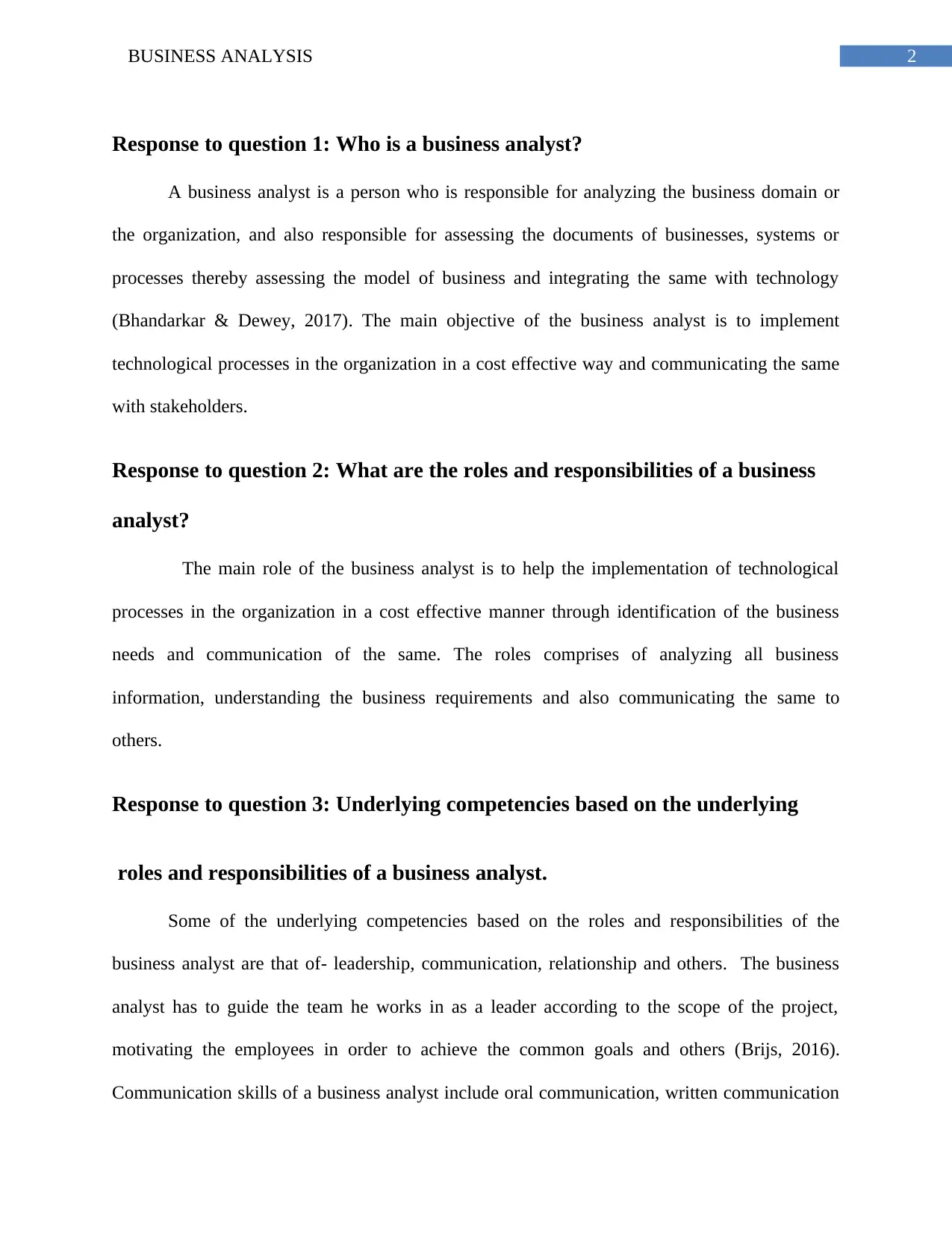
2BUSINESS ANALYSIS
Response to question 1: Who is a business analyst?
A business analyst is a person who is responsible for analyzing the business domain or
the organization, and also responsible for assessing the documents of businesses, systems or
processes thereby assessing the model of business and integrating the same with technology
(Bhandarkar & Dewey, 2017). The main objective of the business analyst is to implement
technological processes in the organization in a cost effective way and communicating the same
with stakeholders.
Response to question 2: What are the roles and responsibilities of a business
analyst?
The main role of the business analyst is to help the implementation of technological
processes in the organization in a cost effective manner through identification of the business
needs and communication of the same. The roles comprises of analyzing all business
information, understanding the business requirements and also communicating the same to
others.
Response to question 3: Underlying competencies based on the underlying
roles and responsibilities of a business analyst.
Some of the underlying competencies based on the roles and responsibilities of the
business analyst are that of- leadership, communication, relationship and others. The business
analyst has to guide the team he works in as a leader according to the scope of the project,
motivating the employees in order to achieve the common goals and others (Brijs, 2016).
Communication skills of a business analyst include oral communication, written communication
Response to question 1: Who is a business analyst?
A business analyst is a person who is responsible for analyzing the business domain or
the organization, and also responsible for assessing the documents of businesses, systems or
processes thereby assessing the model of business and integrating the same with technology
(Bhandarkar & Dewey, 2017). The main objective of the business analyst is to implement
technological processes in the organization in a cost effective way and communicating the same
with stakeholders.
Response to question 2: What are the roles and responsibilities of a business
analyst?
The main role of the business analyst is to help the implementation of technological
processes in the organization in a cost effective manner through identification of the business
needs and communication of the same. The roles comprises of analyzing all business
information, understanding the business requirements and also communicating the same to
others.
Response to question 3: Underlying competencies based on the underlying
roles and responsibilities of a business analyst.
Some of the underlying competencies based on the roles and responsibilities of the
business analyst are that of- leadership, communication, relationship and others. The business
analyst has to guide the team he works in as a leader according to the scope of the project,
motivating the employees in order to achieve the common goals and others (Brijs, 2016).
Communication skills of a business analyst include oral communication, written communication
⊘ This is a preview!⊘
Do you want full access?
Subscribe today to unlock all pages.

Trusted by 1+ million students worldwide
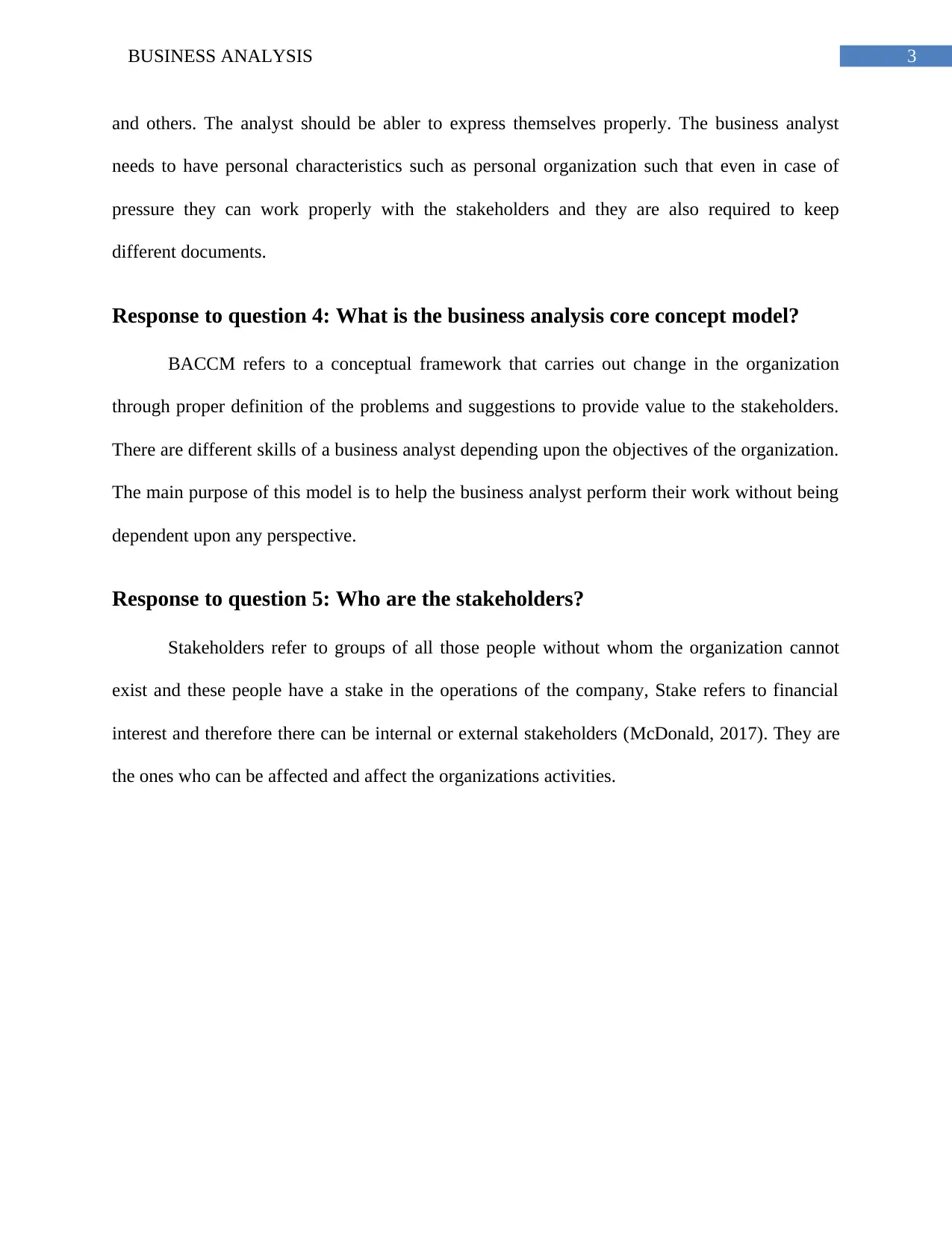
3BUSINESS ANALYSIS
and others. The analyst should be abler to express themselves properly. The business analyst
needs to have personal characteristics such as personal organization such that even in case of
pressure they can work properly with the stakeholders and they are also required to keep
different documents.
Response to question 4: What is the business analysis core concept model?
BACCM refers to a conceptual framework that carries out change in the organization
through proper definition of the problems and suggestions to provide value to the stakeholders.
There are different skills of a business analyst depending upon the objectives of the organization.
The main purpose of this model is to help the business analyst perform their work without being
dependent upon any perspective.
Response to question 5: Who are the stakeholders?
Stakeholders refer to groups of all those people without whom the organization cannot
exist and these people have a stake in the operations of the company, Stake refers to financial
interest and therefore there can be internal or external stakeholders (McDonald, 2017). They are
the ones who can be affected and affect the organizations activities.
and others. The analyst should be abler to express themselves properly. The business analyst
needs to have personal characteristics such as personal organization such that even in case of
pressure they can work properly with the stakeholders and they are also required to keep
different documents.
Response to question 4: What is the business analysis core concept model?
BACCM refers to a conceptual framework that carries out change in the organization
through proper definition of the problems and suggestions to provide value to the stakeholders.
There are different skills of a business analyst depending upon the objectives of the organization.
The main purpose of this model is to help the business analyst perform their work without being
dependent upon any perspective.
Response to question 5: Who are the stakeholders?
Stakeholders refer to groups of all those people without whom the organization cannot
exist and these people have a stake in the operations of the company, Stake refers to financial
interest and therefore there can be internal or external stakeholders (McDonald, 2017). They are
the ones who can be affected and affect the organizations activities.
Paraphrase This Document
Need a fresh take? Get an instant paraphrase of this document with our AI Paraphraser
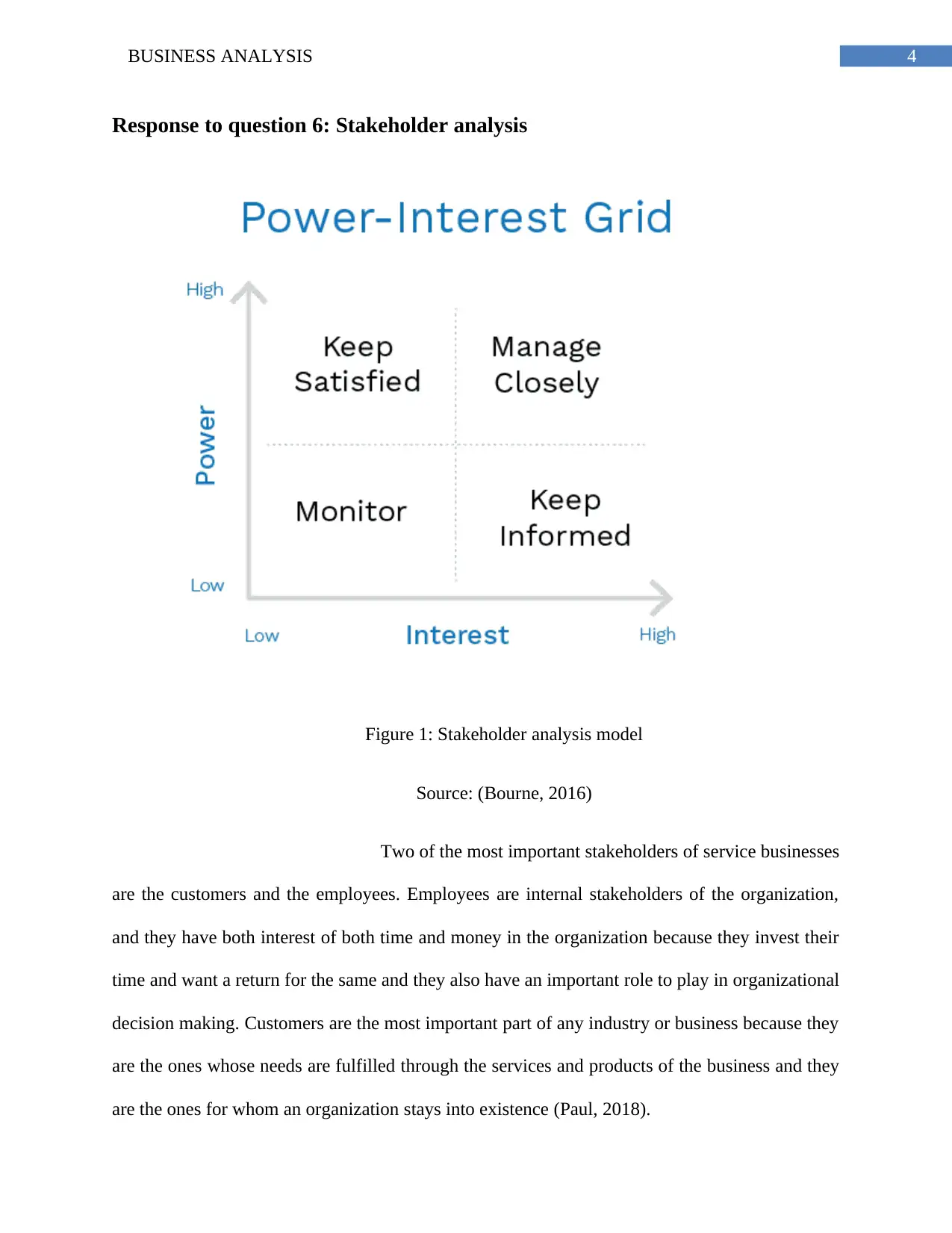
4BUSINESS ANALYSIS
Response to question 6: Stakeholder analysis
Figure 1: Stakeholder analysis model
Source: (Bourne, 2016)
Two of the most important stakeholders of service businesses
are the customers and the employees. Employees are internal stakeholders of the organization,
and they have both interest of both time and money in the organization because they invest their
time and want a return for the same and they also have an important role to play in organizational
decision making. Customers are the most important part of any industry or business because they
are the ones whose needs are fulfilled through the services and products of the business and they
are the ones for whom an organization stays into existence (Paul, 2018).
Response to question 6: Stakeholder analysis
Figure 1: Stakeholder analysis model
Source: (Bourne, 2016)
Two of the most important stakeholders of service businesses
are the customers and the employees. Employees are internal stakeholders of the organization,
and they have both interest of both time and money in the organization because they invest their
time and want a return for the same and they also have an important role to play in organizational
decision making. Customers are the most important part of any industry or business because they
are the ones whose needs are fulfilled through the services and products of the business and they
are the ones for whom an organization stays into existence (Paul, 2018).
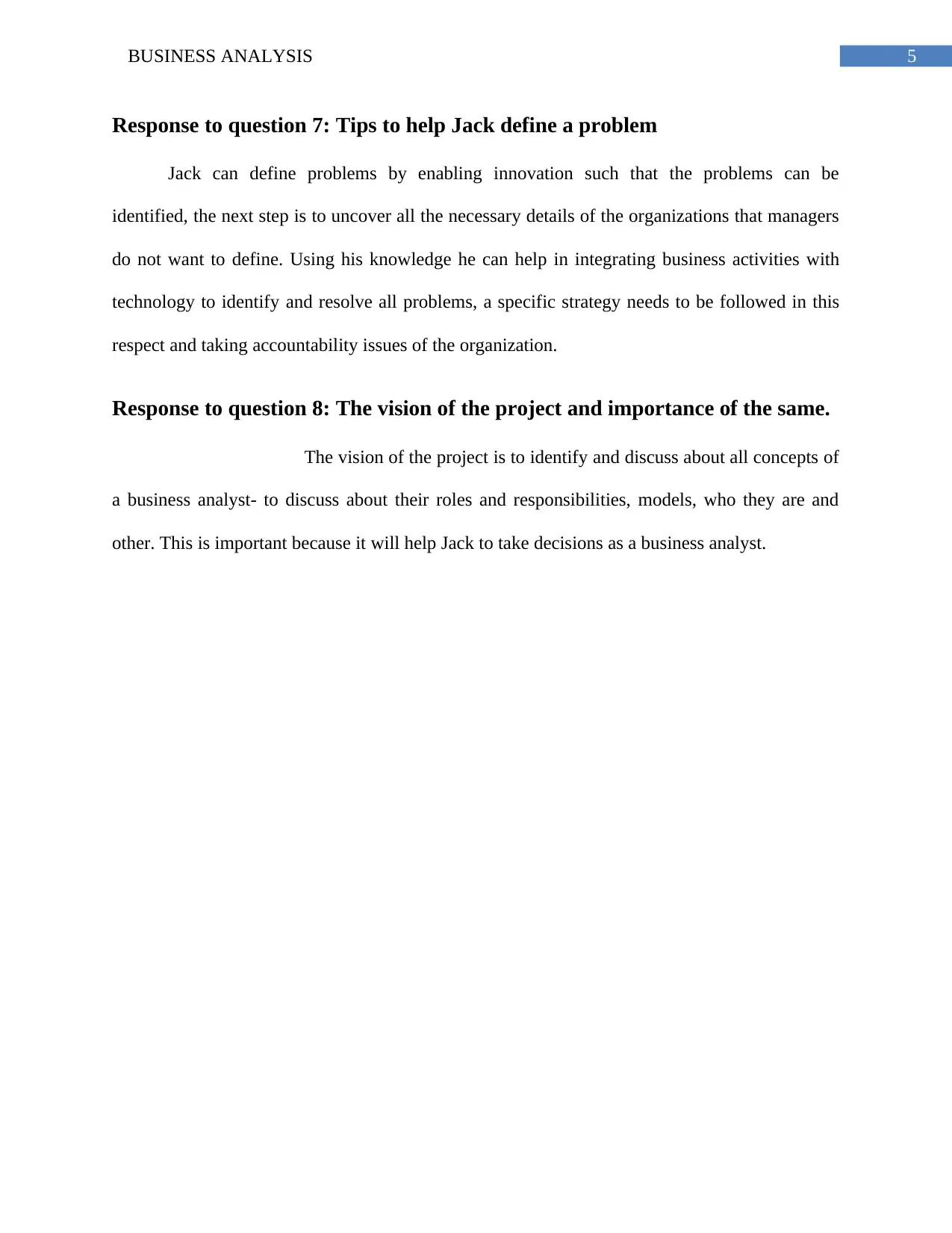
5BUSINESS ANALYSIS
Response to question 7: Tips to help Jack define a problem
Jack can define problems by enabling innovation such that the problems can be
identified, the next step is to uncover all the necessary details of the organizations that managers
do not want to define. Using his knowledge he can help in integrating business activities with
technology to identify and resolve all problems, a specific strategy needs to be followed in this
respect and taking accountability issues of the organization.
Response to question 8: The vision of the project and importance of the same.
The vision of the project is to identify and discuss about all concepts of
a business analyst- to discuss about their roles and responsibilities, models, who they are and
other. This is important because it will help Jack to take decisions as a business analyst.
Response to question 7: Tips to help Jack define a problem
Jack can define problems by enabling innovation such that the problems can be
identified, the next step is to uncover all the necessary details of the organizations that managers
do not want to define. Using his knowledge he can help in integrating business activities with
technology to identify and resolve all problems, a specific strategy needs to be followed in this
respect and taking accountability issues of the organization.
Response to question 8: The vision of the project and importance of the same.
The vision of the project is to identify and discuss about all concepts of
a business analyst- to discuss about their roles and responsibilities, models, who they are and
other. This is important because it will help Jack to take decisions as a business analyst.
⊘ This is a preview!⊘
Do you want full access?
Subscribe today to unlock all pages.

Trusted by 1+ million students worldwide
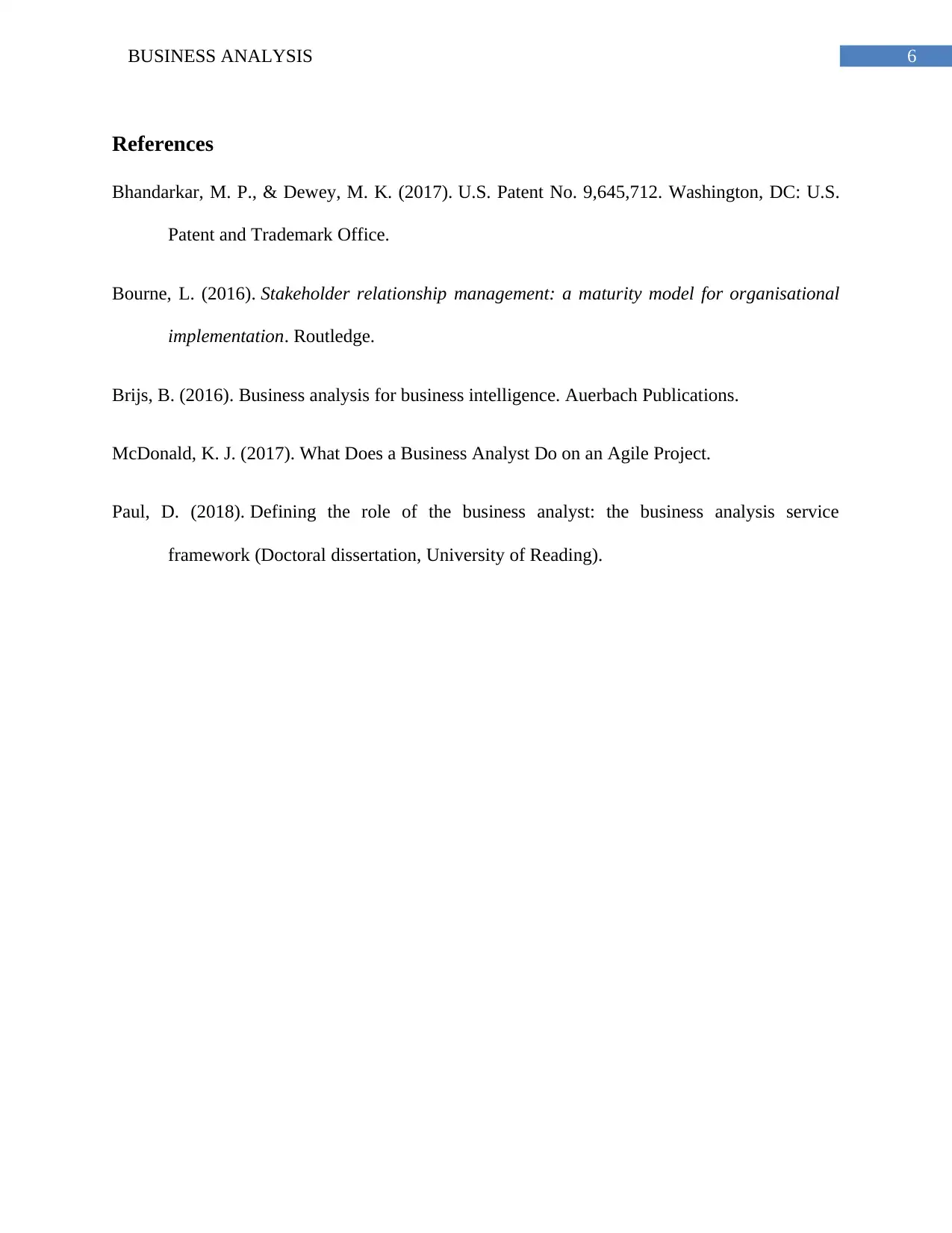
6BUSINESS ANALYSIS
References
Bhandarkar, M. P., & Dewey, M. K. (2017). U.S. Patent No. 9,645,712. Washington, DC: U.S.
Patent and Trademark Office.
Bourne, L. (2016). Stakeholder relationship management: a maturity model for organisational
implementation. Routledge.
Brijs, B. (2016). Business analysis for business intelligence. Auerbach Publications.
McDonald, K. J. (2017). What Does a Business Analyst Do on an Agile Project.
Paul, D. (2018). Defining the role of the business analyst: the business analysis service
framework (Doctoral dissertation, University of Reading).
References
Bhandarkar, M. P., & Dewey, M. K. (2017). U.S. Patent No. 9,645,712. Washington, DC: U.S.
Patent and Trademark Office.
Bourne, L. (2016). Stakeholder relationship management: a maturity model for organisational
implementation. Routledge.
Brijs, B. (2016). Business analysis for business intelligence. Auerbach Publications.
McDonald, K. J. (2017). What Does a Business Analyst Do on an Agile Project.
Paul, D. (2018). Defining the role of the business analyst: the business analysis service
framework (Doctoral dissertation, University of Reading).
1 out of 7
Related Documents
Your All-in-One AI-Powered Toolkit for Academic Success.
+13062052269
info@desklib.com
Available 24*7 on WhatsApp / Email
![[object Object]](/_next/static/media/star-bottom.7253800d.svg)
Unlock your academic potential
Copyright © 2020–2025 A2Z Services. All Rights Reserved. Developed and managed by ZUCOL.





